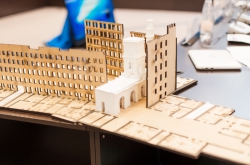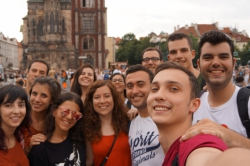How did you come up with such a project?
The thing is, I used to live in a tower-block near Park Pobedy metro station. Apparently, when building the house, the architects didn’t think about how people would approach it or how they would walk to the metro and other attraction points, so the yard was always muddy as people walked on the lawns. I wanted to solve this problem. First I submitted numerous requests to the local authorities and asked them to make paths in particular places. Now I know that it takes the authorities about three to five years, if at all, to lay paths where people actually want to go. That’s why I decided to create a tool that would tackle the problem at its roots. I’ve been working on this topic for about four years.
Why don’t urban planners pay enough attention to pedestrian infrastructure? Indeed, there are many mistakes in path planning, when paths take a long route, have gaps, etc.
The main problem here is that no one wants to finance it. The second problem has to do with the fact that designers who are usually responsible for pedestrian infrastructure often don’t know how to make it right. They just need the investors to find the project appealing, so they design a network of paths as an artistic composition, which only birds can appreciate. People can’t use these paths and form the paths they want across lawns instead.

What do you think about pedestrian infrastructure planning in the Soviet times?
I haven’t seen any successful pedestrian infrastructure projects in residential areas formed in the Soviet times. It’s often not that bad now, as people had formed desire paths which were then paved and integrated into the official path network, but it took ages. I have heard a story about a Soviet town in which land planners deliberately left land fully unpathed, waiting for people to form desire paths, and then paved these paths. But I don’t believe it’s true. I don’t think that anyone would experiment like this back then, in the Soviet Union. But this idea made me think about an algorithm that would simulate pedestrians’ motion and help to design convenient pedestrian path networks. This became my hobby. I published an article on Habr.com about my algorithm; it received many positive reviews, which made me realise that people are interested in solving this problem. Then I met with the representatives of ITMO’s Institute of Design & Urban Studies. They had a project of a park; I processed it with my system and found out that there were mistakes in paths planning.

You’ve also mentioned the ecological aspects of mistakes in pathways planning. What are they?
There are several problems with people walking on the lawns. First, they trample the grass. Second, they turn the lawns into mud and then carry this mud on their feet all over the streets. When the mud dries, it turns into dust and rises into the air, and we breathe it. Of course, cars parking on the lawns cause more dust than pedestrians, but still.
Your project isn’t only about yards, but about parks and gardens as well, is it?
People often think that there is no need for a comfortable pedestrian infrastructure in parks, because people come there to walk. But there are still desire paths in parks. The thing is that people don’t want to go round the park to get to a metro station of a lake, so they go straight through the park. That’s why parks are not different from yards.
How does the system work?
The basic idea is simple: we have a map of the territory and agents trying to take the shortest way. It’s not only the distance that the system takes into account, but also the attractiveness of the pathway: an official paved path has the highest attractiveness, a lawn has the lowest attractiveness, and a desire path is somewhere in between. Pedestrians change the map forming new desire paths which in turn affect the pedestrians’ behaviour. Then we have to decide how to process this information about new paths. Sometimes these new paths just disappear. What is also important is that we divide all the agents into two groups: “decent” and “indecent”. “Indecent” pedestrians always take the shortest way across the lawn and serve as a starting point for forming desire paths, while “decent” pedestrians do not walk on the lawn if it is not very trampled, but they walk the paths that already exist. Two parallel paths often form one, convenient for both “decent” and “indecent” pedestrians, and so it becomes even more trampled. It took us quite a long time to model this situation.

Technically, it works like this: we draw a map, attraction points, such as shops, building entrances, etc., and the system generates agents. The attraction points within the model are divided into “popular” and “less popular”, which correspond to the relative number of people choosing them, e.g. a metro is a very popular attraction point and it generates many agents. The only problem is that we don’t have statistical data on the exact number of pedestrians using these paths.
According to your articles, it is not only Russia who faces this problem with desire paths, but many other countries as well.
Yes, this is true, and we’re going to prove it at the ICCS Conference in China. For this purpose, we’re going to study the public areas in Wuxi (the city where the conference will take place), find the desire paths and show how our algorithm can predict such mistakes in urban planning.

Who is your project aimed at?
There are three categories of organizations that might find our project interesting. First, design companies willing to improve the quality of their work. There is a new trend in urban design, as designers started to realize the importance of infrastructure. Several design companies have already contacted us.
The second category is public organizations, such as “Beautiful St. Petersburg”, as well as public activists and volunteers.
And the third category is the city authorities, such as the St. Petersburg Committee for Architecture and Urban Development. They can use our system to assess projects, as it allows to estimate what would happen to the lawns in a year and how much the repair would cost.
What are you going to do next?
The project is already at that stage that it needs financial support. That’s why we’re trying to make people see that pedestrian infrastructure is important. First of all, we target those engaged in urban design. For example, I give lectures for urban designers at ITMO University and other universities, take part in various conferences. Besides, we have a website, where we write about this problem.




